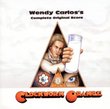| All Artists: Wendy Carlos Title: Rediscovering Lost Scores, Vol. 2 Members Wishing: 4 Total Copies: 0 Label: Voiceprint UK Release Date: 1/13/2008 Album Type: Import Genres: Dance & Electronic, Special Interest, New Age, Pop, Rock, Soundtracks Styles: Electronica, Easy Listening Number of Discs: 1 SwapaCD Credits: 1 UPC: 604388324620 |
Search - Wendy Carlos :: Rediscovering Lost Scores, Vol. 2
 | Wendy Carlos Rediscovering Lost Scores, Vol. 2 Genres: Dance & Electronic, Special Interest, New Age, Pop, Rock, Soundtracks |
Larger Image |
CD DetailsSimilar CDs |
CD ReviewsFinally and Fulfilling! PEZ | CO, USA | 10/28/2005 (5 out of 5 stars) "Believe the hype, _Shining_ fans. These bits and pieces of music - volume 1 focuses more on "studio music and textures" of the themes devised for the film while volume 2 spends its allotted tracks on the more fully developed orchestra tracks - hold just about everything. I'll encourage you to follow that impulse/interest and add this work to your collection. What do you get? Well, for me, the treat was volume 2's first track - the film's title track - Ms Carlos explains why Kubrick nixed it - but it is as haunting as the final draft that follows Jack Torrance's lil yellow bug to The Overlook climbing the Rockies. The other tracks are renderings and attempts to put the novel into music forms. The liner notes are great - like a listening session over coffee with the composer. Both volumes are must haves for those of us all agog over the film's score (and scoring possibilities) but if you just want to hold a haunting, get volume 2 and put track one on repeat until you, that hag hottie in the tub, or your six year old's index finger hollers, "redrum!"" Settling Old Scores Robert Carlberg | Seattle | 10/10/2005 (5 out of 5 stars) "This second volume of Wendy's lost film soundtracks concentrates more on her full orchestral scores. Although she achieved fame as a synthesist, one reason she succeeded so well is her knowledge of and attention to timbral colors and the placement of different voices -- in short, orchestration. It should come as little surprise therefore that when writing for a full orchestra she's fully accomplished and impressively skilled.
Synthesizer cues are also included, from early (1981) novelty demonstrations for Dolby Labs to later (1998) soundtrack work utilizing her state-of-the-art digital synthesizers. As usual for her, voluminous liner notes detail not only the working methods behind each of the pieces, but also glimpses into the politics and disappointments that delayed the release of these tracks. How many composers could survive having a significant portion of their career locked away in a vault for 25 years?" |


![Sonic Seasonings + [Enhanced CD]](https://nationalbookswap.com/cd//m/76/8076/208076.jpg)

